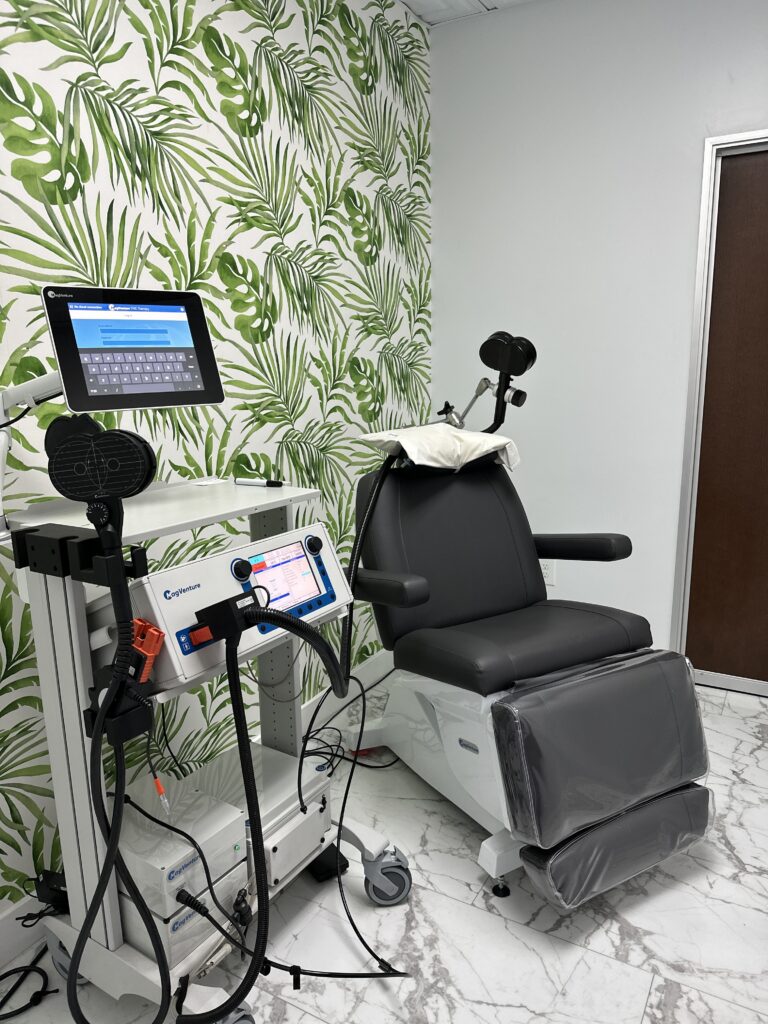Transcranial Magnetic Stimulation (TMS)
Noninvasive procedure using magnetic fields to stimulate nerve cells in the brain to improve symptoms of depression and Treatment Resistant Depression (TRD)
Transcranial Magnetic Stimulation (TMS)
TMS is a quantum leap
forward in treating TRD
Transcranial Magnetic Stimulation (TMS) is a technological breakthrough in the treatment of Major Depression, PTSD, Anxiety, and other disorders. It is an FDA-approved, non-invasive treatment that has been recognized by the American Psychiatric Association in its Best Practices Guidelines as an effective treatment for depression. What is TMS? It’s a safe and effective outpatient treatment for individuals diagnosed with Major Depressive Disorder (MDD) or similar disorders who have not experienced satisfactory improvement from antidepressant medication.

COMMONLY ASKED QUESTIONS
FAQ’S
What is Transcranial Magnetic Stimulation?
Transcranial magnetic stimulation, or TMS, stimulates the brain. Rather than using electrical currents, however, TMS stimulates the brain through the use of powerful magnetic fields. TMS targets specific brain areas that impact depression. The device used in TMS releases a series of repetitive magnetic pulses, stimulating brain areas associated with depression and reducing symptoms. TMS is completely non-invasive, requiring no anesthesia, medication, or surgical incision. Participants are awake and alert throughout the process.
What should I tell my health care provider before starting treatment?
Before you take TMS®, talk to your healthcare provider about your full medical and depression treatment history, including if you have a history of abusing prescription or street drugs, or a problem with alcohol.
Tell your healthcare provider about all the medicines that you take, including prescription and over-the-counter medicines, vitamins and herbal supplements.
What are the Side Effects of TMS?
Most side effects of TMS occur in the first few weeks of treatment, and are typically easy to manage. Some participants may experience a headache during or immediately after a treatment. The headache isn’t a result of any internal stimulation of the brain. Rather, a headache occurs due to the contraction of scalp muscles during treatment, much like a tension headache. In addition, scalp pain or discomfort is another common side effect, which usually resolves after treatment. Similar to scalp contraction, TMS may cause facial pain due to the contraction of facial nerve muscles during the procedure.
Though rare, a more serious side effect of TMS is seizure. The seizures are triggered directly by the TMS treatment, and are isolated incidents. These seizures may last less than a minute, and typically have no other adverse effects. The risk of seizures is the reason why people with a seizure history are not advised to use TMS. Despite it’s infrequent occurrence, professionals delivering TMS treatments are trained to manage seizures in the event that they do occur.
What Does a TMS Treatment Feel Like?
For TMS to be most effective, treatment typically consists of four to five day a week sessions over a period of four to six weeks. The session typically lasts anywhere from 20 minutes to a little less than an hour, depending on the device. During a TMS session, a TMS device — an electromagnetic coil — is gently placed against the scalp in specific areas.
These areas are determined prior to treatment through extensive assessments. The magnetic pulses released by the device stimulates areas of the brain associated with mood and depression, reducing depressive symptoms. For most people, the TMS treatments are painless, though some may experience minor discomfort and headaches.
Is TMS Treatment Effective?
Research shows that TMS is an effective treatment for treatment- resistant major depression, and is slowly being accepted as a treatment option for major depression. A study spanning 42 TMS clinics found that 58 percent of participants found that their symptoms improved. What’s more, 37 percent achieved full remission of their illness. TMS can also be used in conjunction with other therapies, like medication or psychotherapy, and can boost their effectiveness.
TMS and the Future of Treatments?
TMS is not a magic bullet for the treatment of major depression. The brain remains a mystery, and the mechanism by which TMS works is still not well understood. That said, TMS opens doors for other methods of treatment for mood disorders and depression. With TMS comes the new frontiers in brain research and psychiatric treatment, providing hope for all people with depression.
What do I do if it does not work for me?
Not all patients will respond to TMS. Your healthcare provider may decide that you complete the first four weeks of TMS® treatment to see whether or not you have had satisfactory improvement of depressive symptoms. If you’ve done this, talk to all of the healthcare providers involved in the management of your treatment about appropriate next steps. Do not stop your TMS® treatments without first discussing your reasons and concerns with your healthcare provider and formulating a treatment plan with them.
Main Office
17167 VENTURA BLVD #300
Encino, CA 91316-4004
Call: 877-390-2216
Monday to Friday : 9am – 8pm
Saturday : 10am – 7pm
Our Treatment Resistant Depression programs are effective for managing depression, anxiety, bipolar, and post traumatic stress disorder.